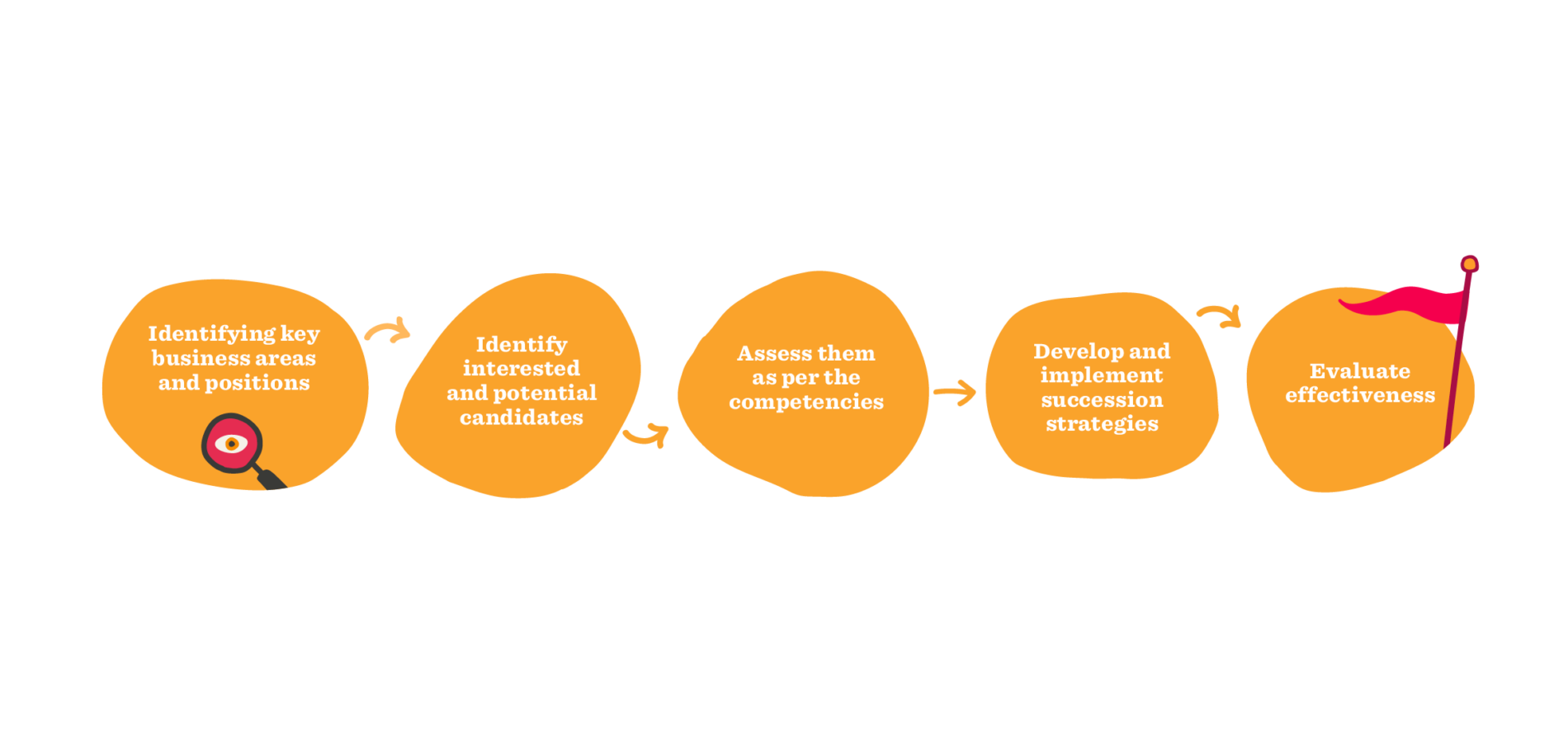As the world struggles with an impending economic recession and strained living costs, it’s no surprise that companies are interrogating their hiring, retention, and redundancy practices.
Keeping your budget lean and maximizing the productivity of your teams is key to surviving the turbulent climate in which we find ourselves. For most businesses, that means that promoting your existing talent into leadership positions is likely to be an effective strategy.
As well as keeping costs under control, growing leaders from within is one of the best ways of making sure you’re ready for anything that might come your way and keeping morale and team happiness high.
We’re going to explore why it’s so important and look at what you can do to develop the great leaders of tomorrow.

Why great leadership is so significant for your company
As we edge toward a global recession it’s no surprise to see companies worldwide taking stock and becoming more careful with their spending.
In times like these, investing in internal mobility is the best way to not only help your people thrive through change but also to develop the skills and attributes that your teams need to flourish.
Leadership skills will make or break your company’s employee engagement, wellbeing, and performance levels. Both in large businesses and in growing start-ups, successful leaders have a significant role to play in inspiring greatness, improving happiness, and delivering better results. And while we all strive to put excellent people in managerial roles, there’s no guarantee they possess the qualities needed to bring out the best employee performances, improving productivity and the bottom line.
According to the Society for Human Resource Management (SHRM), new hires cost an average of $4,700, rising up to three or four times the position’s salary when you add in the “soft costs” of training and development support from other team members. That’s a substantial outlay in times of tightening budgets.
During a recession, those kinds of expenses simply become impossible to sustain, so it’s crucial that you work to retain as much of your top talent as you can and avoid the need for too much external recruitment.
At the same time, recent research suggests a striking decline in the quality of leaders in businesses around the world, with reports of high-quality leaders down 17 percentage points to just 40 percent in DDI’s 2023 Global Leadership Forecast. Confidence in leadership is also down, as people lose trust and confidence in those in charge, as is the delivery of the kind of training and learning opportunities that your future leaders crave.
With leaders more in demand—and more aware of their value than ever—working hard to retain their services should be a top priority for HR leadership. Now is the time to take an in-depth look at your company’s organization chart and ponder some critical questions: Who are the leaders? Where are the weakest links? And what needs to change to help the business succeed?

Developing your people to become great leaders
The benefits of development programs
Many companies offer development programs to their new talent early on, to teach them skills and help advance their careers, but these can then disappear entirely once someone has been with the company for a year or more.
These offerings range from broad programs that might include career-specific training or personal career development opportunities focused, for example, on time management or computer software training. Such programs enable you to assess people’s strengths and weaknesses and identify budding leaders.
While this is fairly standard practice, it’s tempting to overlook training programs when times get more difficult. However, it’s important to reinforce skills and help people learn new ones, especially as the demands on your business change. Doing so speaks volumes about your company culture, too, demonstrating to everyone that you care about your people’s future development and opening up career paths.
In turn, team members are likely to collaborate more freely and effectively and feel more committed and loyal to your organization. Not only does internal mobility increase people’s confidence, but it also reduces costs and improves retention. Similarly, your reputation as a fair, supportive, and caring employer will rise, helping you to make exceptional new hires when and where those are needed.
Think about high potential, and not just high performance
According to Gartner, high-potential employees (HIPOs) with potential leadership skills are those who exert 21 percent more effort than their co-workers and have a 75 percent chance of succeeding at roles that are critical to the performance of the business and the future leadership pipeline.
So while it’s important that you invest significant resources in developing your star performers in order to lay the foundations for effective succession planning, these individuals won’t stand out based on performance alone. They will also display an aspiration for leadership, autonomy, flexibility, commitment to the company, and a capacity for fast-paced work. On top of that, high-potential team members tend to:
- Require little direction, because they have a deep understanding of their work and can offer solutions rather than just problems
- Produce high-quality work, meeting goals and achieving deadlines even when under pressure
- Welcome opportunities to demonstrate leadership traits, helping to make sure projects are completed efficiently
- Take the initiative and support the success of the company
- Be invested in your wider company goals
- Have healthy, positive relationships with others, motivating and supporting their team members
- Be flexible and adaptable in the face of change
- Express a desire to improve, learn, and perform to exceed their own expectations
Clearly, people with the potential to take on new responsibilities and become good leaders aren’t only those hitting their targets: They also demonstrate their promise by exhibiting certain personality traits and emotional intelligence.
Developing leaders from within
Once you’ve pinpointed potential leaders within your organization, it’s crucial that you cultivate their development in the best way possible. Here are our top tips that managers at all levels can follow to motivate their people and give them the tools they need to progress:
- Create an ownership mentality by entrusting your people to make decisions independently
- Promote interaction with other leaders, encouraging networking and forging mentor relationships
- Encourage opportunities to learn more about the industry, for example, by participating in conferences and thought leadership
- Issue challenges and allocate side projects to encourage people to think out of the box, helping to reveal high-potential employees who have bought into your company culture and are keen to succeed
- Rotate positions so that people experience new functions and gain a better understanding of the business and how everything works
- Support, inspire, and navigate by offering guidance and creating space for learning
The best training takes place across a combination of online platforms, training days, and on-the-job learning so that your future leaders can sharpen their skills in the real world. With a boom in remote and hybrid arrangements, learning should reach your people wherever they are, working around their schedules and circumstances to help them truly reach their best.
How HR can help
As an HR leader, you are likely a key driver in stewarding your business’s succession planning, supported by company leadership and other stakeholders. While in some companies, succession planning is limited to executive roles, companies with wider succession plans are better equipped for today’s climate of agile businesses responding to challenging times.
By partnering with line managers, customers, and other key figures, you can more accurately gauge the changing needs of your business. This analysis will help you identify the right criteria for pinpointing the kind of top performers you need, whether to fill a skills gap or expand your teams’ capabilities. This kind of valuable information will help you to build an effective succession plan without wasting time and effort trying to fit square pegs into round holes.
Your company will benefit from a clear strategy to shape the career progression of your emerging leaders. With your broad perspective of the dynamics and structure of your organization, you are well-placed to propose new roles, identify vacant opportunities, and help to shape your business to ride out the economic downturn.
How do you build an effective succession plan?

By following these steps, you can identify which people possess transformational leadership qualities that make them right for a managerial and leadership development path. Improving the skills of your existing leaders and coaching those who might lead in the future will give your company long-lasting roots and a stable future.
But how can you spot people with leadership potential? Which managerial traits are indisputably essential, and which may signal trouble down the road?
Spotting potential leaders (and identifying toxic ones)
“Leadership is not about titles. It is not about seniority. It is not about status, and it is not about management. Leadership is about power and the ability to know when and how to use it to influence the people around you to do and become more! Transformational leadership is about using your actions to elevate others and put them on their path to greatness.”
Terina Allen, Management Consultant
What traits do successful managers exhibit?
Here’s how to identify leadership potential: While good managers can vary in leadership style and character, most transformational leaders tend to be:
- Able to stimulate intellect
- Influential with authority figures
- Genuine and clear communicators
- Able to motivate others and get them on board
- Loyal and committed to your company’s vision and mission
- Well rounded
- Inspiring but not overbearing
- Adaptable and flexible
- Highly emotionally intelligent and empathetic
While possessing these qualities is a good sign, they don’t guarantee that a manager will be successful. These days, managers who take a more supportive, coaching-style approach rather than an authoritarian one are proving effective, as they help people feel valued and build up their strengths.
In a hybrid world, good leaders must be able to bring dispersed teams together and must be skilled decision-makers who can adapt to the changing workplace. With economic and financial anxiety affecting many people, organizational transparency is the answer, so help your managers prepare for the most common questions they’re likely to be asked.
With a strong sense of principle, a commitment to your values, and a professional approach, today’s managers can support an empathetic culture of excellence, helping your teams through the upcoming recession.

Which traits should you be wary of?
We’ve all heard the saying “People leave managers, not companies,” which originated as a chapter heading in Victor Lipman’s book The Type B Manager: Leading Successfully in a Type A World. Ringing true to many, this has become something of a slogan.
Toxic leader traits typically include:
- Narcissism and placing reputation and individual performance above all
- Deception and manipulation to advance their own agendas
- Controlling behavior
- Poor communication
- Being quick to blame and slow to give credit to others
- Being likely to abuse their authority through intimidation or by rewarding those who support their destructive tendencies
- Pitting individuals or teams against each other
Toxic leadership doesn’t occur overnight. It develops over time. So identifying it before it causes too much damage is key.
How HR can help
As the gatekeepers of company culture, HR leaders and company executives must exhibit zero tolerance for toxic leadership behavior. Given the far-reaching implications for the company, it is your role to act as a guardian of the company, ensuring the necessary checks and controls are in place.
Processes such as performance reviews and one-on-one interviews are natural places for red flags to emerge. An open-door policy and regular anonymous surveys support a feedback culture that enables whistleblowing and encourages everyone to share their views and voice their concerns. During recruitment, you can also work to assess personality traits and attitudes by clearly defining your culture and the expectations that come with it.
Make sure those traits aren’t a symptom of excessive and unreasonable demands being placed on those leaders, such as those solely focused on financial numbers and immediate results. And once you identify leaders demonstrating dangerous traits which cannot be resolved, you might find ways of moving them into positions with a narrower sphere of authority, where they no longer manage individuals.
Why growing your people beats hiring from outside
In difficult times, many people look to someone from outside to shake things up and bring “new ideas.” However, that’s not always the right move. As we’ve seen, it can cost a lot of time and money to source an external hire, and there’s no guarantee that they will fit your culture or prove effective in the role.
On the other hand, identifying leadership potential and hiring internally has many benefits during a recession. Promoting leaders from within means:
- Saving on recruitment costs
- Employing a known quantity with proven potential
- Getting someone who is familiar with your business and its people, and can hit the ground running
- A leader who needs a shorter learning curve to become acquainted with stakeholders and key processes
- Supporting more effective knowledge transfer across departments, units, and international borders
While finding internal leaders requires a careful calculation of their competencies and skills, attitude, habits, culture, and passion to make sure they’re right for the position, it has a hugely positive impact on building retention and igniting personal aspirations among your people. The high level of engagement it drives and the loyalty it instills in your teams will pay dividends in the long run, building a resilient company spirit and enthusiasm for the work.
How HR can help
There’s no such thing as a one-size-fits-all approach when it comes to company policy, but by encouraging job openings to be posted internally, you can help managers to explore the potential talent pool already within your teams. Build on your succession strategy with effective training, and ensure both recruiters and managers are discussing career growth and specific jobs with current team members. If you run on the assumption that your people are always on the lookout for better opportunities, you can make sure that your pitches stack up against the competition.

Recommended For Further Reading
Meet Bob
We know how important it is to make holistic, data-driven decisions about your people, especially in light of today’s workplace changes and economic challenges. That’s why we built Bob, an employee experience platform that develops leaders and helps them adapt to modern practices and the latest tech while boosting morale and lengthening their lifecycle.
The main functions Bob uses to spot and inspire its future leaders can be found in the Performance, Culture, and Surveys features.
Bob grows great leaders
Performance – bring out the best in your people:
- Goal-setting helps managers support growth
- Reviews are completely customizable
- Dashboards help spot top performers
Surveys – drive engagement through feedback:
- Understand employees’ perspectives
- Track milestones and lifecycle events
- View insights by team, site, and gender
Culture – create a unique sense of belonging:
- Communicate with company-wide messages
- Map out your people’s networking hubs
- Create personalized hobbies and clubs
